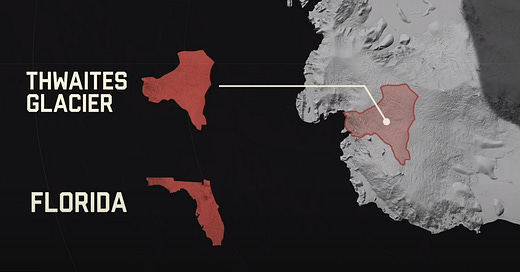
The Thwaites Glacier, a Florida-sized mass of ice at the coast of Western Antarctica, has been called the “doomsday glacier” because of its potential to wreak havoc all by itself.
For example, consider its size:
This Vox video from 2020 gives a good, if too-calming view of the process by which Thwaites has been disappearing for decades.
Jump to the 2:29 minute mark to see a visualization of the undercutting in action.
“How soon that happens is hotly debated” says the narrator at 3:33. That was in 2020. Not so much anymore.
‘It will take decades, not centuries’
From CNN on May 21 (via the excellent climate news aggregator, The Collapse Chronicle):
Ocean water is rushing miles underneath the ‘Doomsday Glacier’ with potentially dire impacts on sea level rise
…Thwaites, which already contributes 4% to global sea level rise, holds enough ice to raise sea levels by more than 2 feet. But because it also acts as a natural dam to the surrounding ice in West Antarctica, scientists have estimated its complete collapse could ultimately lead to around 10 feet of sea level rise — a catastrophe for the world’s coastal communities.
Many studies have pointed to the immense vulnerabilities of Thwaites. Global warming, driven by humans burning fossil fuels, has left it hanging on “by its fingernails,” according to a 2022 study.
CNN doesn’t link to the study. The UC Irvine announcement is here. The paper itself is here.
The lead author, Eric Rignot, has been quoted as saying, “The projections will go up … [The collapse] will take many decades, not centuries. Part of the answer also depends on whether our climate keeps getting warmer or not”.
Needless to say, the climate keeps getting warmer. And don’t trust the word “many.” He’s trying not to scare you too much.
Our Bet with the Future
No one says this will happen immediately. “Decades” are still not next year. But global sea surface temperatures are setting new records, and at an accelerating pace.
As you can imagine, there’s a certain freaking out caused by this, more so from scientists (see also here and here) than from those who owe their lives to the moneyed class.
In how “many decades” could this all occur? My money’s on two or three, by the mid-2050s.
Global Sea Level Rise vs. Sea Levels Near You
But whatever the time scale for Thwaites’ complete collapse, the change it will bring won’t be smooth, but sudden, in stages. If a Florida-sized chunk of ice that’s not submerged, suddenly falls into the sea, it will raise sea level globally — on its own — by as much as two feet.
And that rise won’t be well distributed. The sea near New York, for example, will rise 1½ times the global average:
The Thwaites collapse, when it comes, will change everything. And the Western Antarctic collapse, following that, will ice the rest of the cake. The first could come in the next twenty years or so — remember, everything’s accelerating.
And the second … well, when that arrives may not matter at all, given how scrambled our eggs will be by then.
The Solution
The solution, of course, is action of a “vigorous” kind. The State knows this far better than most. That’s why it’s been gearing up. We’ll look at that soon.






Add another meaning for the term "sunk costs"!
I live at the foot of the Catskill and Shawangunk Mountain ranges in the southern part of Upstate New York. There has already been some migration here from NYC due to COVID. Where people will settle from Long Island and the five boroughs is hopefully a problem I wont face. What areas will not be awash may still be uninhabitable due to salt water intrusion into the ground water. I think that most of New Jersey will be at risk from flooding or ground water contamination.
Planning for an ominous future needs consideration. Harboring resources for this long term emergency needs to start. Every dollar sunk into our military industrial complex wastes our capacity to prepare for what comes.
It won't take 10 feet of sea level rise to be a catastrophe to cities and nations; 3 feet is more than enough to constitute a "catastrophe". And the nations are planning for it, by building up their militaries, so they can squash the inevitable riots and societal collapse when our economies and food sources collapse along with the rising water.